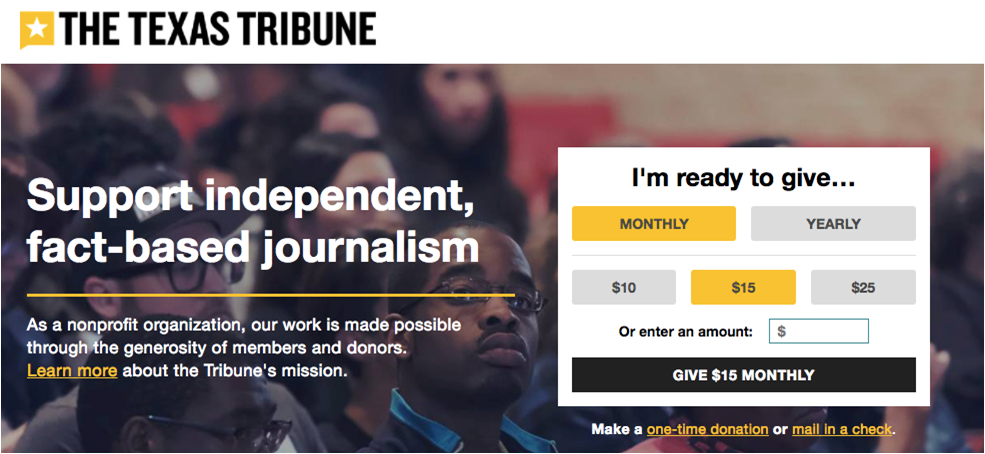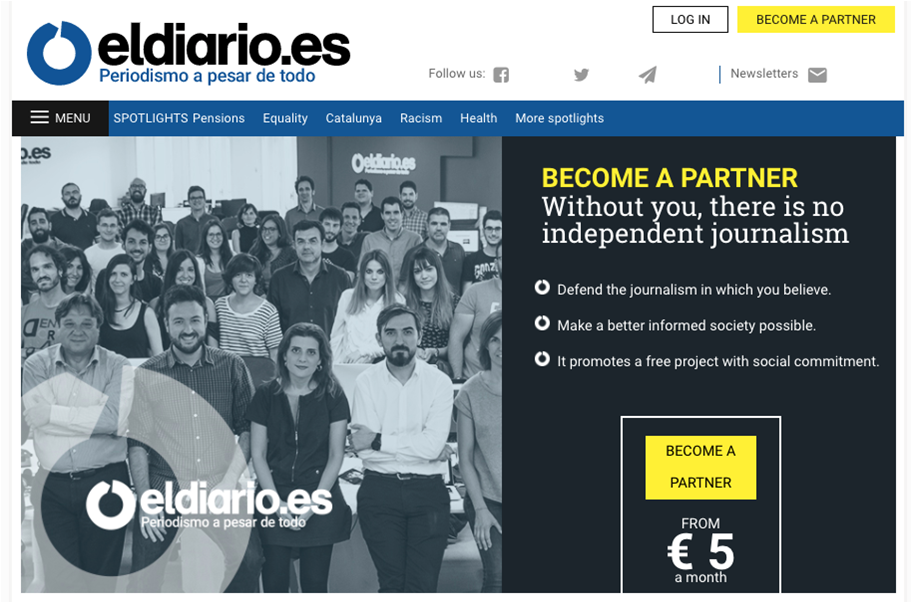While some countries see significant progress in persuading consumers to pay for digital subscriptions, this is proving more challenging for less wealthy countries, for poorer groups, and for particular types of content that are democratically important or less commercially valued.
In these cases, donations could be emerging as one way of maintaining existing legacy news organisations and funding new enterprises. News organisations like the Guardian are building their future business on the back of donation-based membership, while our country pages are full of examples of new crowdfunded start-ups. In this chapter we look at the extent and limits of this approach across countries and explore the reasons why more people are donating to news, with a focus on the US, Spain,1 and the UK.
Overall we find that the percentage of people donating to news organisations is small, just 1% in the UK rising to 3% in the US. But the scale of the opportunity looks to be much greater, with on average, a quarter of our sample (22%) saying they might be prepared to donate to a news organisation in the future if they felt if could not cover their costs in other ways.
Who Donates to News Organisations?
Donations tend to come from the younger half of the population. This millennial group is more confident about paying for online services in general and gives more regularly to online charities.2 As our own research into paying for news showed last year, many younger people are reluctant to sign up for just one subscription for fear of missing out on being able to pick and choose sources. Any message that suggests contributions might keep journalism open is likely to work well with this group.
GUARDIAN MESSAGING THAT APPEARS ON MOST NEWS STORIES
Many donations are also politically driven, with the vast majority coming from the centre or the left. In part this is a reflection of historical ideological battles, when many left-wing newspapers were funded by co-operatives or unions as a counter to a capitalist-funded press. But in countries like the United States the media are again increasingly seen as part of a political struggle – between supporters and opponents of Donald Trump. In this context, our open-ended survey responses suggest that donation is often seen as a political act:
I donate in support of the First Amendment, which I feel is under attack by this administration.
(M, 34, US)
I want to make sure those news outlets stay open.
(F, 64, US)
But donations are not exclusively the preserve of the left, with partisan conservative sites increasingly appealing to their supporter base to donate — especially as many advertisers are now boycotting these sites.
Tradition of Philanthropy in the United States
A wide variety of publications ask for donations in the United States. NPR has been running funding drives for decades and the bulk of its revenue comes this way (for radio and now its popular website). The same is true for local NPR and PBS affiliates. Some thriving local news providers, such as the non-profit Texas Tribune and Mississippi Today also ask for reader contributions, stressing in their messaging the benefits of a fact-based approach. Launched in 2009, the Tribune generates $6.5 million in annual revenue, with a staff of nearly 60 people.
This messaging is designed to strike a chord with those who are worried about fake news, partisan news, and poor journalism.
I now realise that good journalism requires money. If I keep relying only on free news stories, the quality of journalism I get will be dumbed down and made much worse.
(M, 52, US)
For others, the rise of subscription has raised concerns about a two-tier system, where high-quality news is reserved for those who can afford it. This is why some organisations prefer to keep access free but ask for voluntary contributions. The majority of the Guardian’sone-off donations come from the United States.3
I paid for The Guardian because I read its work and it doesn’t have a paywall. I didn’t pay as much as I would for a typical year’s subscriptions, though, because I don’t read it very often.
(F, 60, US)
In this respect the donation model may be a good fit for the Guardian outside the UK, as they are unlikely to be first choice for an expensive subscription but provide a strong value-based proposition for those with a liberal outlook. For similar reasons, there is also a wide range of small blogs and writers that are starting to use donations as a model.
I feel that independent journalists bring truth to what is going on in the world. Aeon Magazine, Medium, Elephant Journal, Carolyn Baker – these are examples of who I pay to support.
(F, 60, US)
Respondents in our survey repeatedly talked about wishing to support independent writers, even if they don’t use them every day. Regular donations or one-off tips for well-researched articles are one way of showing appreciation.
Donations and Crowdfunding in Spain
Independent media in Spain have been experimenting with a range of donation models for years. This has been important in a country with little tradition of print subscription and where journalism is threatened by declining revenues and a perceived lack of independence.
It is the only way to maintain free media that is independent of political power.
(M, 45, Spain)
As far back as October 2015, El Español ‘raised €3.6m (£2.6m; $4m) through equity crowdfunding. [At launch] it had 5,624 small shareholders and around 10,000 subscribers. But now its strategy has switched to ongoing donation models, something it has in common with many other digital-native news organisations.
These usually take the form of voluntary subscriptions or memberships, pioneered by Vilaweb in Catalonia and successfully adopted by Eldiario.es, which had more than 30,000 members in April 2018.4 Users donate money on a regular basis and obtain extra benefits in return such as an ad-free website or participating in meetings. The annual membership fee is €60 though you can choose to donate more.
The key messages are about defending journalism and improving society –ideas that strike a chord with many of our respondents.
Paying a subscription or giving a donation is, for my part, a way to maintain a service to the community.
(M, 70, Spain)
Reasons for Donations — United Kingdom
In the UK, news has traditionally been supplied by a strong and vibrant commercial newspaper sector, commercial TV, and the publicly funded BBC. Donation is a relatively new concept. Just 1% of our sample gives to a news organisation and from comments it is clear that most are donating to the Guardian. This is not surprising given that very few others are asking for donations. A key motivation is a desire to preserve one of the few mainstream news organisations with a distinctly liberal agenda.
It is important that the Guardian continues to be available to counter nearly all the other newspapers which are right-wing.
For others, donation is more about guilt. Respondents say they used to pay for the printed paper but now access it free on the internet, so they feel they should contribute.
A few other small UK publications that now ask for donations were also mentioned by respondents. These include bloggers and political sites like pro-independence Scottish site Bella Caledonia and Scot goes Pop. The Canary is a left-wing partisan site that relies on monthly contributions from around 1,500 supporters.
Across all countries we find that donations are increasingly asked for, and increasingly given. Part of the motivation is to support fact-based journalism in an era of fake news and support a greater variety of independent voices. But many of our respondents also talked about giving money because they wanted to identify with a cause, or set of values. This matters because it deepens the relationship between some audience members and some journalists at the same time as potentially increasing the supply of more partisan journalism.
Perhaps the most significant finding is that younger groups are most likely to give money for news. Donations may help bridge the gap between paying nothing and an expensive subscription, but they also work better for a generation that likes to access multiple sources on multiple devices. For both these reasons we can expect pay-as-you-go models like donations and crowdfunding to be an increasingly important part of the picture.
- For information about donations in Spain we are grateful to Samuel Negredo Bruna and the team at the University of Navarra. ↩
- https://www.thebalance.com/how-millennials-have-changed-charitable-giving-2501900 ↩
- https://www.theguardian.com/gnm-press-office/2018/jan/26/guardian-us-reaches-milestone-with-over-300000-paying-supporters-in-america ↩
- https://l.eldiario.es/30000-socios/ ↩





